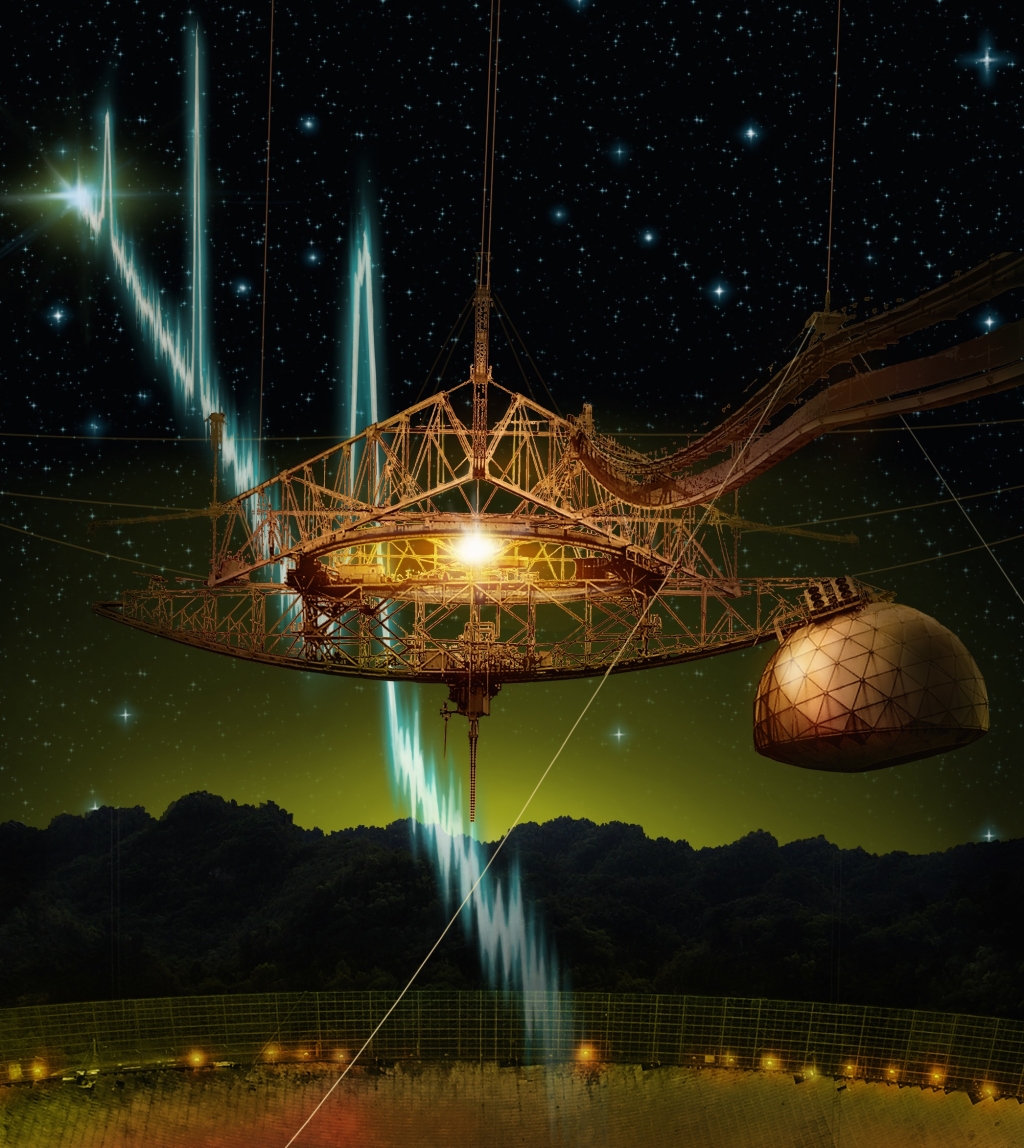In the News: "Fast Radio Bursts" & Lunine Backs Seafaring Trips to Other Worlds
March 7th, 2016
Sifting Cornell data, astronomers find repeating bursts
Cornell senior researcher Shami Chatterjee, M.S. ’00, Ph.D. ’03, and James Cordes, the George Feldstein Professor of Astronomy and Spitler’s doctoral adviser, measured the burst properties and searched for counterparts at other wavelengths. Their work demonstrates that the probable source of these pulses is a young, highly magnetized neutron star in another galaxy, a big step forward in our understanding of these enigmatic FRBs. The team has conducted follow-up observations with the Jansky Very Large Array, the Chandra and Swift X-ray telescopes, and the Arecibo, Green Bank, Effelsberg, and Jodrell Bank radio telescopes, and more results are on their way.
"Fast Radio Bursts”, or FRBs, are single millisecond-long radio pulses that appear to come from outside our Galaxy. Only 17 of these bursts had been seen till now, and they were one-off events, consistent with the release of a prodigious amount of energy in a distant explosion. In 2014, Laura Spitler, M.S. ’10, Ph.D. ’13, discovered one of these FRBs in Arecibo observations, confirming that these were astrophysical, rather than some form of interference unique to the Parkes radio telescope where all previous bursts had been found. After combing through survey observations conducted at Arecibo and archived at the Cornell Center for Advanced Computing, an international team of astronomers led by Spitler, McGill University graduate student Paul Scholz, and University of Amsterdam astronomer Jason Hessels are reporting that the source of the FRB detected in 2014 emits repeated pulses. The discovery of ten new pulses from the FRB source immediately rules out entire classes of theoretical models – such as explosive mergers of neutron stars – for at least this one FRB source.
Cornell Chronicle: http://www.news.cornell.edu/stories/2016/03/sifting-cornell-data-astronomers-find-repeating-bursts
Paper (Spitler et al. 2016, Nature): http://www.nature.com/nature/journal/vaop/ncurrent/full/nature17168.html
Washington Post: https://www.washingtonpost.com/news/speaking-of-science/wp/2016/03/02/new-paper-adds-a-surprising-twist-to-the-cosmic-hunt-for-fast-radio-bursts/
Scientific American: http://www.scientificamerican.com/article/the-recurring-question-where-do-fast-radio-bursts-come-from/
Additional News: In D.C., Lunine Backs Seafaring Trips to Other Worlds
 A team of Cornell astronomers have confirmed that the
hydrocarbon seas on Saturn's moon Titan are dynamic environments. In
2013, anomalously bright features were discovered in Titan's hydrocarbon sea
Ligeia Mare by Cornell astronomy graduate student Jason Hofgartner, faculty
members Alexander Hayes and Jonathan Lunine, and the Cassini RADAR Science
Team. These features which were not present in previous observations of
Ligeia Mare were predicted to be transient features that were the result of an
ephemeral phenomenon in the sea. This exciting discovery motivated the
Cassini mission to re-observe the transient region of Ligeia Mare in 2014 and
2015. Bright features were detected in the 2014 observation but not the
2015 observation. In a paper published in the journal Icarus, Cornell
astronomers and the Cassini RADAR Science Team used these new observations to
confirm the conclusion that the anomalous bright features are indeed
transient. From analysis of all of the observations of this enigmatic
region of Titan, the team concluded that waves is the most likely hypothesis
for these transient features. Floating or suspended solids and bubbles
however are also consistent with the observations. The team determined
that tides, sea level change, and seafloor change are unlikely causes for the
appearance of the transient features. The Cassini spacecraft is scheduled
to re-observe Ligeia Mare during its final close flyby of Titan in April of
2017 and this observation may further elucidate the nature of the transient
features. Cornell astronomers in the new study are Jason Hofgartner, a
recent Ph.D. graduate and now a NASA Postdoctoral Program Fellow at the Jet
Propulsion Laboratory, Alexander Hayes, Assistant Professor of Astronomy,
Jonathan Lunine, David C. Duncan Professor in the Physical Sciences and
Director of the Cornell Center for Astrophysics and Planetary Science (CCAPS),
and Marco Mastrogiuseppe, CCAPS research associate.
A team of Cornell astronomers have confirmed that the
hydrocarbon seas on Saturn's moon Titan are dynamic environments. In
2013, anomalously bright features were discovered in Titan's hydrocarbon sea
Ligeia Mare by Cornell astronomy graduate student Jason Hofgartner, faculty
members Alexander Hayes and Jonathan Lunine, and the Cassini RADAR Science
Team. These features which were not present in previous observations of
Ligeia Mare were predicted to be transient features that were the result of an
ephemeral phenomenon in the sea. This exciting discovery motivated the
Cassini mission to re-observe the transient region of Ligeia Mare in 2014 and
2015. Bright features were detected in the 2014 observation but not the
2015 observation. In a paper published in the journal Icarus, Cornell
astronomers and the Cassini RADAR Science Team used these new observations to
confirm the conclusion that the anomalous bright features are indeed
transient. From analysis of all of the observations of this enigmatic
region of Titan, the team concluded that waves is the most likely hypothesis
for these transient features. Floating or suspended solids and bubbles
however are also consistent with the observations. The team determined
that tides, sea level change, and seafloor change are unlikely causes for the
appearance of the transient features. The Cassini spacecraft is scheduled
to re-observe Ligeia Mare during its final close flyby of Titan in April of
2017 and this observation may further elucidate the nature of the transient
features. Cornell astronomers in the new study are Jason Hofgartner, a
recent Ph.D. graduate and now a NASA Postdoctoral Program Fellow at the Jet
Propulsion Laboratory, Alexander Hayes, Assistant Professor of Astronomy,
Jonathan Lunine, David C. Duncan Professor in the Physical Sciences and
Director of the Cornell Center for Astrophysics and Planetary Science (CCAPS),
and Marco Mastrogiuseppe, CCAPS research associate.
Cornell Chronicle: http://www.news.cornell.edu/stories/2016/03/surfs-saturns-geologically-active-moon-titan
ICARUS: http://www.sciencedirect.com/science/article/pii/S0019103516000890

